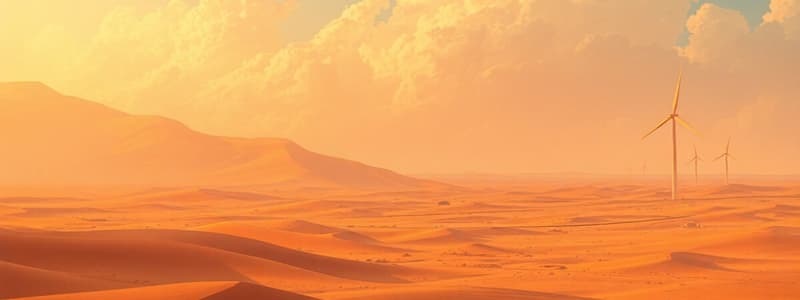Podcast
Questions and Answers
The Thar Desert possesses mineral reserves like feldspar and kaolin, which are essential in the production of items ranging from cement to ______.
The Thar Desert possesses mineral reserves like feldspar and kaolin, which are essential in the production of items ranging from cement to ______.
fertilizers
In the Thar Desert, energy generation utilizes solar panels for water desalination and wind energy, with one wind farm having the capacity to produce 60 ______ of electrcity.
In the Thar Desert, energy generation utilizes solar panels for water desalination and wind energy, with one wind farm having the capacity to produce 60 ______ of electrcity.
megawatts
The creation of commercial arable farming in the Thar Desert, facilitated by ______, has contributed to job creation and income generation for the local economy.
The creation of commercial arable farming in the Thar Desert, facilitated by ______, has contributed to job creation and income generation for the local economy.
irrigation
The Thar Desert National Park attracts visitors keen on observing the local wildlife, boosting tourism, which in turn drives local job creation and income through the ______ effect.
The Thar Desert National Park attracts visitors keen on observing the local wildlife, boosting tourism, which in turn drives local job creation and income through the ______ effect.
Cultivating crops, working in mines, or guiding tourists in the Thar Desert becomes challenging due to extreme weather; temperatures can rise above ______ degrees Celcius during the summer months.
Cultivating crops, working in mines, or guiding tourists in the Thar Desert becomes challenging due to extreme weather; temperatures can rise above ______ degrees Celcius during the summer months.
Sustainable water management is essential in the Thar Desert, where the annual rainfall is limited to 120-240 mm, and over-irrigation can result in ground ______ and soil salinization.
Sustainable water management is essential in the Thar Desert, where the annual rainfall is limited to 120-240 mm, and over-irrigation can result in ground ______ and soil salinization.
The extensive area of the Thar Desert, covering 200,000 sq km, presents challenges to development because extreme conditions and inadequate infrastructure render most of the area ______.
The extensive area of the Thar Desert, covering 200,000 sq km, presents challenges to development because extreme conditions and inadequate infrastructure render most of the area ______.
The constraint of inaccessibility in the Thar Desert has led to the emergence of ______ sites such as Jaisalmer, where tourism is heavily concentrated, while other areas remain underdeveloped.
The constraint of inaccessibility in the Thar Desert has led to the emergence of ______ sites such as Jaisalmer, where tourism is heavily concentrated, while other areas remain underdeveloped.
Flashcards
Mining in the Thar Desert
Mining in the Thar Desert
Extraction of valuable minerals like feldspar, gypsum and limestone from the desert.
Energy Generation in the Thar Desert
Energy Generation in the Thar Desert
Generating power using solar panels and wind turbines in the desert environment.
Irrigation in the Thar Desert
Irrigation in the Thar Desert
Making crop production possible in the desert through controlled watering techniques.
Commercial Arable Farming
Commercial Arable Farming
Signup and view all the flashcards
Tourism in the Thar Desert
Tourism in the Thar Desert
Signup and view all the flashcards
Extreme Temperatures (Thar Desert)
Extreme Temperatures (Thar Desert)
Signup and view all the flashcards
Water Supply (Thar Desert)
Water Supply (Thar Desert)
Signup and view all the flashcards
Waterlogging in the Thar Desert
Waterlogging in the Thar Desert
Signup and view all the flashcards
Study Notes
- Despite its harsh climate, the Thar Desert presents opportunities for development.
Mining
- The desert possesses valuable mineral reserves, including feldspar, phospherite, gypsum, and kaolin, essential for producing cement and fertilizers.
- Limestone and marble are also extracted for building and construction purposes.
Energy Generation
- Solar panels generate energy.
- This energy powers the desalination of saline water supplies.
- Wind energy contributes electricity; a 75-turbine wind farm can produce 60 MW of electricity.
Farming
- Irrigation enables commercial arable farming, fostering the cultivation of wheat and cotton.
- Crop production stimulates job creation and income generation for the local economy.
Tourism
- The Thar Desert National Park attracts visitors to observe its 120 species.
- Tourists explore the desert using local guides and camels.
- Tourism serves as a vital income source.
Development Challenges
- Extreme temperatures exceeding 50°C during summer impede farming, mining, and tourism activities.
- With limited rainfall (120-240 mm annually), water is a precious resource.
- Over-irrigation in certain areas causes waterlogging and salinization, hindering crop growth.
- The desert's vast expanse (200,000 sq km) and harsh conditions limit accessibility and infrastructure development.
- Limited accessibility concentrates tourism in areas like Jaisalmer.
Studying That Suits You
Use AI to generate personalized quizzes and flashcards to suit your learning preferences.




